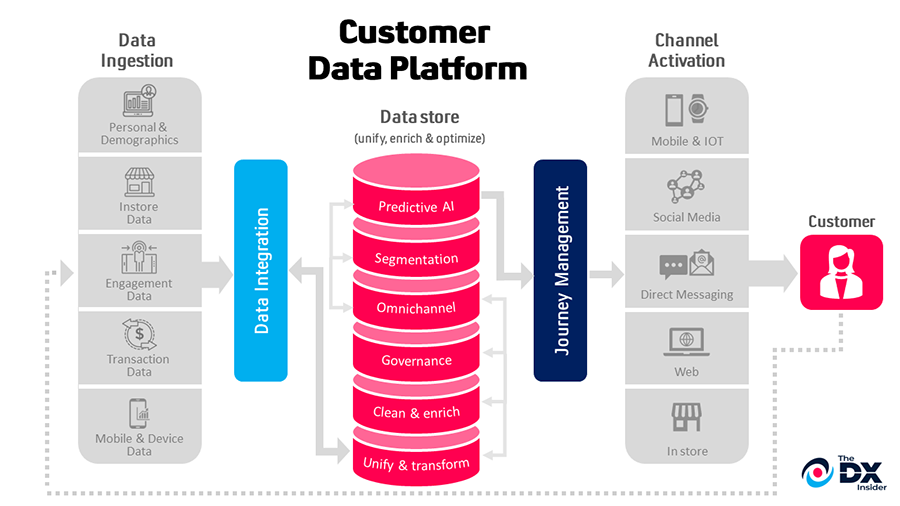The business case for Customer Data Platforms
While many digital experience (DX) ecosystem components garner significant attention, one key technology often remains overlooked: the Customer Data Platform (CDP). Despite being a highly impactful tool, it remains underestimated and underused in composable commerce and DX solutions. A CDP does more than just collect and structure customer data from various sources—it constructs a unified, 360-degree view of each customer. This holistic understanding of customer behavior and preferences enables brands to craft highly tailored and engaging experiences across all touchpoints. Yet despite all this potential, the CDP often remains underutilized, overshadowed by more prominent components of e-commerce and DX solutions. In this our second installment on technologies often overlooked in a composable DX stack, we shed light on the critical role of CDPs and explore how CDP can significantly enhance customer engagement, loyalty, and overall digital experiences that ensure brands can get the most out of their composable DX or commerce solutions.
As the digital world becomes increasingly interconnected, the sheer volume of customer data generated across various touchpoints can be overwhelming. This is where a Customer Data Platform (CDP) comes in play, equipping brands with the ability to take control of their customer data and use it to their advantage.
A Customer Data Platform (CDP) is a specialized software application that amasses, consolidates, and systematizes customer data from a myriad of sources. It crafts a comprehensive, unified customer profile and stores it within a centralized database. This data encapsulates aspects such as customer behavior, transactional details, and demographic insights, all integral to comprehending customer preferences and patterns. Beyond just data aggregation, a CDP incorporates an activation layer, equipping brands with the capability to effectively employ this data across multiple channels.
In contrast to other platforms, like Customer Relationship Management (CRM) systems or Data Management Platforms (DMPs), a Customer Data Platform (CDP) offers a holistic, 360-degree perspective of each customer, emphasizing the collection of first-party and second-party customer behavior data. DMPs typically gather third-party data, whereas CRMs concentrate on directly recording interactions between a brand and its customers.
It is common for a CDP to be integrated with both CRM and DMP systems. This integration provides brands with a comprehensive understanding of their customers, enhancing their ability to deliver personalized and pertinent customer experiences.

Here are the high-level activities carried out by a CDP to activate data for channel use
-
Ingest data from different channels. The CDP ingests data from different marketing channels, such as websites, email, social media, and mobile apps. This data can include customer contact information, purchase history, website behavior, and social media engagement.
-
Unify the data into a single view. The CDP then unifies the data into a single view of the customer, combining data from different channels to create a comprehensive view of each customer.
-
Activate the data for channel use. The CDP then activates the data, making it available to customer engagement channels so that brands can engage customers with personalized, relevant experiences.
The relationship between a Customer Data Platform (CDP) and a Digital Experience Platform (DXP) is symbiotic in nature. While the CDP indeed supplies the comprehensive customer data that a DXP solution utilizes to enhance customer experiences, its value extends much further. Let's explore the ways in which a CDP bolsters brands in their digital experience strategies.
The need to move to a first-party data strategy
As regulatory laws become more stringent due to growing privacy concerns, digital marketers face a significant challenge: the phasing out of third-party cookies. Cookies have been a fundamental part of digital marketing, offering valuable insights into consumer behavior by tracking their online activities. Consequently, brands need to transition to a first-party data strategy. A Customer Data Platform (CDP) plays a pivotal role in this strategy. It helps brands maximize the value of their first-party data by:
-
Providing a unified view of their customers: A CDP collects data from different sources, such as CRM systems, marketing automation platforms, and website analytics. This data is then unified into a single customer profile, which gives brands a holistic view of each customer.
-
Enabling effective audience segmentation: A CDP can be used to segment customers into groups based on their interests, demographics, and purchase history. This allows brands to target customers more effectively.
-
Generating real-time and predictive insights: A CDP can be used to generate real-time and predictive insights into customer behavior. This allows brands to make better decisions about how to reach and engage their customers.
-
Ensuring privacy compliance: CDPs include data governance capabilities that help ensure the data collected is compliant with various data protection regulations, such as the General Data Protection Regulation (GDPR) in the EU, the California Consumer Privacy Act (CCPA) in the US, and other similar laws around the world. This can include features to support data subject rights, such as data access requests, data portability, and the right to be forgotten. This is important because brands can be fined heavily for non-compliance.
Enabling adavanced DX capabilities that drive better customer engagement
As mentioned earlier, a CDP creates a single, holistic view of a customer by collecting data from all their touchpoints. This data can include their purchase history, website activity, social media interactions, and customer service records. By having a unified customer view, brands can better understand their customers' needs and preferences, which enables brands to execute more personalized and relevant digital experience strategies such as:
-
Optimize web experiences for specific customer segments: CDPs enable brands to segment their customers based on various criteria, such as purchase history, browsing behavior, demographic information, and more. These segments can then be used to target and optimize digital experiences for a specific customer segement.
-
Personalization: With the detailed customer profiles that a CDP provides, e-commerce businesses can personalize their marketing messages, product recommendations, and overall customer experience. This can lead to increased customer engagement, higher conversion rates, and increased customer loyalty.
-
Journey Mapping and Orchestration: A CDP can aid in mapping out the customer journey by tracking all key touchpoints and behaviors. This can provide valuable insights into how customers move through the sales funnel, where they drop off, and what factors influence their purchasing decisions.
Furthermore, journey orchestration tools can use the data from a CDP to trigger and automate personalized experiences in real-time across different touchpoints in a customer's journey, improving customer experience and boosting sales and ROI. For example, if a customer abandons their shopping cart, a brand can immediately send a cart abandonment email to try to recapture the sale.
-
Website Search: Advanced intelligent website search applications like Algolia and Coveo leverage AI to optimize search capabilities, requiring data for maximum effectiveness. A CDP can supply these AI-powered search tools with the necessary data, enhancing personalization of search results, improving search relevance, suggesting related content, and enabling measurement of search effectiveness.
-
Generative AI and Generative DX: Similar to AI-powered search, generative AI models require data to learn and generate outputs. A CDP can supports Generative AI by providing high-quality, real-time customer data for training and enabling AI-powered DX solutions to generate personalized content and recommendations, adapt to changes in customer behavior, and continuously improve its performance.
-
Predict Customer Future Needs - CDPs offer predictive analytics capabilities, using machine learning algorithms to predict future customer behavior based on past data. This can help brands anticipate customer needs, optimize their inventory, and proactively address potential issues.
Now considering the numerous advantages of a CDP, why is it, that it often gets overlooked during a rollout of a Composable Digital Experience (DX) or commerce solution? The most common reasons are as follows:
-
Lack of Awareness: Some businesses may not be aware of what a CDP is or the benefits it can provide. They might be using other tools for data management and not realize that a CDP could provide a more comprehensive and efficient solution.
-
Lack of Clear Ownership: It may not be clear who within the organization should own the CDP - IT, marketing, sales, or another department. This lack of clear ownership can lead to delays or indecision in implementing a CDP.
-
Perceived Relevance: Some businesses may not see the relevance of a CDP to their specific industry or business model. They may believe that their current systems are sufficient for their needs.
-
Overlapping Capabilities: Some businesses may feel that their existing tools, such as CRM systems, marketing automation platforms, or data warehouses, already provide some of the capabilities of a CDP. They may not see the value in implementing a separate platform.
-
Time to Value: Implementing a CDP and integrating it with existing systems can take time, and it may take even longer to start seeing the benefits. Some businesses may prefer to focus on initiatives with quicker returns.
Other reasons include: Concerns over data privacy or data quality, the cost and complexity of implementing CDP, as well as just being overwhelmed with determining the best CDP solution with so many options in the market. Despite these potential barriers, as awareness of these benefits grows, more and more brands are likely to incorporate CDPs into their Composable DX solutions.
In summary, the Customer Data Platform (CDP) is a crucial element for brands prioritizing digital customer experience. Incorporating these platforms within a composable DX strategy allows brands to provide personalized, consistent, and superior customer experiences across all digital touchpoints.
As we look to the future, it becomes clear that Artificial Intelligence (AI) and Machine Learning (ML) are set to assume an increasingly pivotal role in molding and enhancing digital experience solutions as the DX industry transitions towards Generative DX. The need for ready access to comprehensive customer data to drive these advanced technologies will be paramount.
Brands prepared to embrace this integration stand to gain immensely, with benefits spanning from enhanced customer satisfaction and increased return on investment (ROI), to deepened customer loyalty.
If you would like to learn more, reach out to us, and we can help connect you with CDP experts or connect with a CDP vendor. We have also provided a few CDP vendors to consider including in your evaluation of CDP solutions below:
Customer Data Platform Vendors
Twilio Segment: a good choice for brands focused on creating personalized customer journeys across platforms based on real-time data.
Bloomreach Engagement: a good choice for commerce-oriented brands and brands that are focused on utilizing MACH technologies in their composable DX stack.
Treasure Data CDP: particularly well-suited for brands focused on predictive analytics that want to unify massive amounts of customer data and have unique needs that may require extensive customization.
Adobe Real-Time CDP: well-suited for brands already using Adobe Experience Manager that want to deliver personalized experiences across all channels, improve customer engagement and loyalty, or comply with data privacy regulations.
Salesforce CDP: tightly integrated with Salesforce ecosystem, this solution is well-suited to brands already using Saleforce CRM.
Oracle Unity : well-suited for brands that want to unify customer data, deliver personalized experiences across all channels, use AI and machine learning to improve their customer experiences, or comply with data privacy regulations.

CMS-Connected Media Corp.
We provide website services for clients worldwide, specializing in Web CMS solutions using Kentico, SharePoint, e-Spirit, Sitecore, Sitefinity, Ektron & Elcom

John Austin
As an industry veteran in the digital experience space, John is a digital strategist with a deep understanding of DXP solution ecosystems.